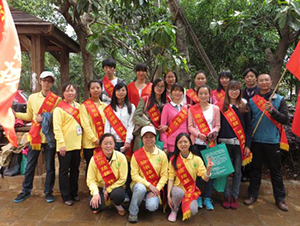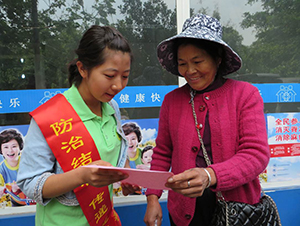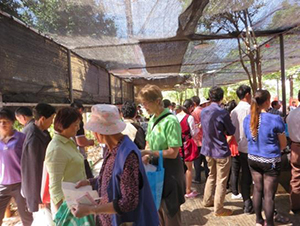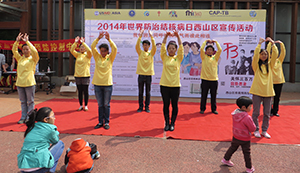Home \ Health Education Projects \ Kunming Tuberculosis (TB) Control Project
Background
According to the most recent Tuberculosis (TB) survey in China (2010) the TB incidence rate in West China is 695 cases per 100,000 people, thereof 105/100,000 smear-positive. China is also a country burdened heavily by Multi-Drug resistant TB (‘MDR-TB’).
The awareness of TB and MDRTB – especially in rural areas and among migrant workers from rural areas – is low (HPP baseline of June 2010 showed 16%, while the national goal is 80%) and migrant workers are considered High Risk Population for TB – and therefore proper health education and mobilization is needed.
Project startup
Since 2009 with funding from the Global Fund to Fight AIDS, Tuberculosis and Malaria HPP China and with support from Yunnan Centres for Disease Control and China Centres for Disease Control, the HPPC TB Program provided more than 160,000 migrant workers in Guandu and Xishan Districts in Kunming with TB and MDRTB health education and trained and mobilized, more than 460 small and medium enterprises to implement TB prevention strategies in the work place.
HPPC successfully completed the Global Fund Round 8 and NSA TB programs during October 2009 to December 2011. Therefore the National Project Office invited us to bid for a 2012 project. The project started in August 2012 and finished in May 2013. The last round project started in 2013 and finished in June, 2014.

Project Activities
Activity 1: Outreach education at work places
Contents: There are two types of outreach education at work places: The first one is outreach workers visiting work places to provide education, and help them to develop work plan on TB (MDRTB) prevention; the second one is assisting CDC to advocate and provide training on TB (MDRTB) prevention at work places every Thursday. Two kinds of teaching methods are adopted: 30 minute lecture at lunch time or after work time, 45 minute lecture during work time or organized in cooperation with Nanba Labor Market. The similar activities are conducted at places where most high risk population for TB live such as construction sites, factories, restaurants, hostels, etc. Education contents: TB (MDRTB) symptoms, transmission routes, prevention and treatment, government policies, rights and interests of TB patients, reasons for reducing stigma and discrimination, etc. The education focuses on TB. 45 minute lecture include co-infection of TB and HIV, mobilizing suspected people for TB test. Generally, the activities are organized by outreach workers, lectures at large workplaces are organized by project manager. Participatory methods such as asking questions and discussion are used, supplemented with slide show when condition permits. Fliers on TB prevention and treatment knowledge are distributed and posters are put up at workplaces. Passive screening questionnaires are distributed to all who are interested.
Participants need to register and sign their names. If possible, stamped by manager at the workplace. If managers at the workplaces want to, the project helps them to develop TB prevention and treatment plan at workplace based on the standard model developed by project. Project manager or outreach workers assist managers at workplace to develop plan after training at workplace. Agreement on TB prevention and treatment plan are signed afterwards.
Activity 2: Face to face education on TB prevention and treatment knowledge among people who apply for health certificate
Contents: outreach workers conduct face to face education or group (7 people)education among people who come to Xishan District CDC for health certificate during the time 10-20 minutes while waiting: educate TB symptoms, transmission routes, prevention and treatment knowledge. Mobilize suspected TB patients for test. Set up education board in labor market if permitted. Distribute fliers on TB prevention and treatment knowledge among risk population for MDRTB. Put up posters at workplace. Distribute passive screening questionnaires to people who are interested. Refer suspected TB patients to CDC.
Activity 3: Large scale activities
Contents: two large scale TB (especially MDRTB) education activities are conducted at places where most high risk population for TB stay including drama, short sketch, price-giving quiz, slogan propaganda, etc. It takes 1-2 hours for each activity. Local leaders and health education professionals are invited to give speech and dance team or chorus with local characteristics are invited to perform. Provide education on TB (especially MDRTB) prevention and treatment knowledge and response measures for suspected TB patients. Distribute fliers on TB prevention and treatment. Develop education board with TB knowledge and national policies. Distribute passive screening questionnaire to all who are interested. Meanwhile, the project will conduct health education on TB in schools where there are many high risk population for TB among grade three and above primary school students and their parents.
Activity 4: Training of TB patients and their families on MDRTB knowledge
Contents: conducted in Kunming No. Three People’s Hospital and Kunming TB Prevention and Treatment Hospital. Provide training to patients and their families on MDRTB knowledge, medication guide and nursing knowledge. Assist patients to develop self support network for continuous support among themselves after project completed.
Activity 5: Training of outreach workers
Contents: the outreach workers receive on-the-job training, monthly training, and quarterly training. Monthly training includes work plan and work report of the previous day. Quarterly training takes one day which include background and objective of Global Fund Project, TB epidemic trend in China, Yunnan, Kunming and the world, TB knowledge, symptom, infection routes, diagnosis, treatment and prevention, communication skills of effective health education, development of good relationship with target population, mobilization of suspected patients for test, introduction to background information of high risk population for MDRTB, work forms, plan and report system, financial statement, work progress and welfare, team building, experience sharing and discussion of problems encountered. Various methods like participatory training methods, interaction methods, lecture, outreach role play are adopted.
Activity photos: 


Project news:
We are connected by the air we breathe: World TB Day educational event